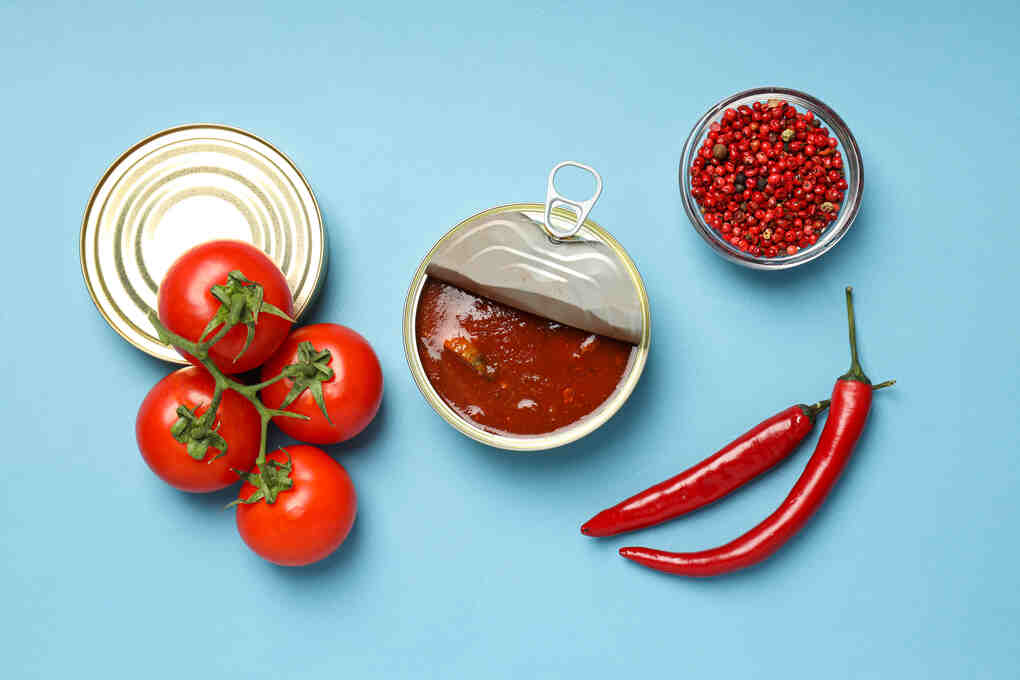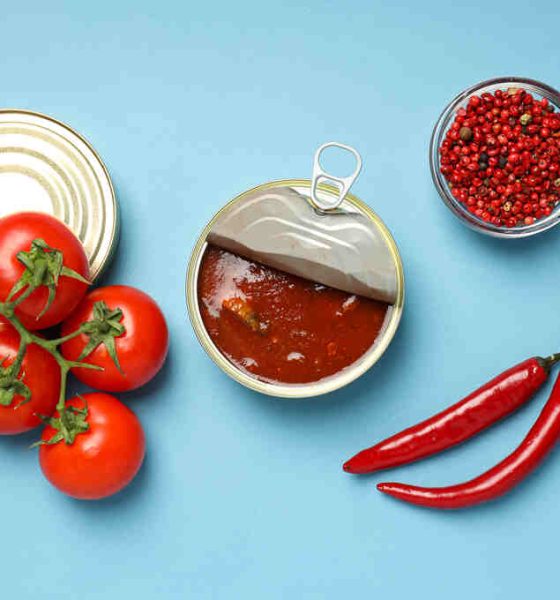

How-Tos
The Case of the Canned Tomato Sauce: A Detective’s Guide to Perfect Preservation
![]()
It was a sultry summer afternoon when the call came in. A frantic voice on the other end of the line muttered something about a surplus of tomatoes and a desperate need to preserve their bounty. The challenge was clear: solve the mystery of canning tomato sauce. As a seasoned detective, I knew this case would require a meticulous approach, blending science and culinary art.
Gathering the Evidence
1. Selecting the Right Tomatoes
The first step in our investigation involved selecting the perfect tomatoes. The ideal candidates for canning are plum varieties, such as Roma or San Marzano. Their meaty texture and lower water content make them perfect for a rich, thick sauce. Inspect each tomato for blemishes or soft spots; only the finest specimens would do.
2. Assembling the Tools
Every good detective knows that having the right tools is essential. For this case, we needed:
- A large pot for boiling water
- A paring knife and cutting board
- A food mill or blender
- A heavy-bottomed pot for cooking the sauce
- Canning jars, lids, and rings
- A jar lifter
- A canning funnel
- A ladle
- A canning pot with a rack
The Initial Interrogation
3. Preparing the Tomatoes
We began by blanching the tomatoes to remove their skins. Here’s how it went down:
- Fill a large pot with water and bring it to a boil.
- Score a small “X” on the bottom of each tomato.
- Prepare an ice water bath in a separate bowl.
- Gently place the tomatoes in the boiling water for about 30-60 seconds until the skins start to peel away.
- Immediately transfer the tomatoes to the ice water bath to halt the cooking process.
Once cooled, the tomatoes’ skins slipped off easily, revealing the juicy flesh beneath.
4. Crushing the Suspects
Next, we needed to break down the tomatoes. Using a paring knife, we cored and chopped them, discarding any green or tough parts. A food mill or blender would come in handy to create a smooth puree. The key was to maintain the integrity of the sauce without introducing too much air, which could spoil the final product.
Cooking Up Clues
5. Cooking the Sauce
With the tomatoes prepped, it was time to cook the sauce. We transferred the tomato puree into a heavy-bottomed pot and brought it to a simmer over medium heat. As the tomatoes cooked down, their flavors intensified. To add depth, we included:
- 1 finely chopped onion
- 4 cloves of minced garlic
- Fresh basil leaves
- A pinch of salt
- A teaspoon of sugar (optional, to balance acidity)
Stirring occasionally, we allowed the sauce to simmer for about 45 minutes to an hour, until it reached the desired consistency.
6. Adjusting Acidity
One crucial aspect of canning tomato sauce is ensuring the right acidity level to prevent bacterial growth. Adding bottled lemon juice or citric acid to each jar ensures safety. The standard measure is:
- 2 tablespoons of bottled lemon juice or ½ teaspoon of citric acid per quart jar
- 1 tablespoon of bottled lemon juice or ¼ teaspoon of citric acid per pint jar
Preservation Process
7. Sterilizing the Jars
Before we could proceed with canning, we needed to sterilize the jars. We placed the jars in a large canning pot filled with water, brought it to a boil, and let them sit for 10 minutes. The lids and rings were kept in hot, but not boiling, water to prevent damage to the sealing compound.
8. Filling the Jars
Using a canning funnel, we carefully ladled the hot tomato sauce into the sterilized jars, leaving about ½ inch of headspace at the top. This space allows for expansion during processing. We ran a clean knife or spatula around the inside edge to remove air bubbles, wiped the rims with a damp cloth, and placed the lids on top. The rings were screwed on just fingertip-tight to allow air to escape during processing.
Final Investigation
9. Processing the Jars
With the jars filled and sealed, it was time for the final step: processing in a boiling water bath. We placed the jars in a canning rack and lowered them into the canning pot filled with boiling water, ensuring the water covered the jars by at least an inch. The processing times were as follows:
- 40 minutes for pint jars
- 45 minutes for quart jars
At sea level. For altitudes above 1,000 feet, additional processing time was required.
10. The Cooling and Sealing
After the processing time, we carefully removed the jars using a jar lifter and placed them on a towel to cool. The jars should not be moved or disturbed for 24 hours. As they cooled, we listened for the satisfying “ping” of the lids sealing—a sound that confirmed our efforts had been successful.
Closing the Case
11. Checking the Seals
After 24 hours, we checked the seals by pressing down on the center of each lid. A properly sealed lid would not flex. Any jars that did not seal properly needed to be refrigerated and used within a week.
12. Labeling and Storing
Finally, we labeled the jars with the date and contents before storing them in a cool, dark place. Properly canned tomato sauce can last up to a year, ready to be enjoyed at any time.
The Detective’s Tips
13. Variations on the Theme
For those who enjoy variety, adding different herbs and spices can create unique flavors. Consider including:
- Oregano and thyme for an Italian twist
- Cumin and chili powder for a Mexican flair
- Bay leaves and parsley for a classic touch
14. Troubleshooting
If you encounter issues such as floating tomatoes or separation, don’t fret. Floating can be minimized by packing the jars tightly and removing air bubbles. Separation is natural and can be reduced by thoroughly cooking the sauce before canning.
The Satisfied Detective
With the mystery of canning tomato sauce unraveled, I stood back and admired the rows of neatly sealed jars. Each one represented a successful investigation into the world of home preservation. Whether you’re a novice or an experienced canner, the satisfaction of creating your own tomato sauce is unmatched. The case was closed, but the journey of culinary discovery had just begun.
So, there you have it, a detective’s guide to canning tomato sauce. With careful preparation, attention to detail, and a bit of detective work, you too can solve the mystery of preserving the season’s bounty. Happy canning!
How-Tos
How to Avoid a Consumerist Lifestyle: A Guide for Millennials Worldwide

![]()
In today’s hyper-connected world, the temptation to indulge in a consumerist lifestyle is stronger than ever. Social media feeds are flooded with influencers flaunting luxury goods, advertisers bombarding us with targeted ads, and societal pressures pushing us to “keep up with the Joneses.” For millennials—arguably the most marketed-to generation in history—resisting the allure of materialism can feel like an uphill battle. Yet, breaking free from a consumerist mindset is not only possible but essential for achieving financial stability, mental peace, and long-term fulfillment. This article explores practical strategies to help you avoid falling into the trap of consumerism while fostering habits that prioritize meaningful living over mindless consumption.
Understanding Consumerism
Before diving into solutions, it’s important to understand what consumerism entails. At its core, consumerism is a cultural and economic system that encourages the acquisition of goods and services in ever-increasing amounts. It thrives on the idea that happiness, success, and self-worth are tied to material possessions. While capitalism has undeniably driven innovation and progress, unchecked consumerism often leads to debt, environmental degradation, and a perpetual cycle of dissatisfaction.
For millennials, who face unique challenges such as rising living costs, student loan debt, and uncertain job markets, succumbing to consumerist behaviors can exacerbate financial stress and hinder personal growth. The good news? With awareness and intentionality, you can break free from this cycle and build a life rooted in purpose rather than possessions.
Why Should You Avoid Consumerism?
1. Financial Freedom
Consumerism often lures individuals into spending beyond their means, leading to credit card debt and financial instability. By avoiding unnecessary purchases, you can save more, invest wisely, and achieve greater financial independence.
2. Mental Health Benefits
Studies show that excessive consumption correlates with increased anxiety, depression, and feelings of inadequacy. Shifting focus away from material wealth allows you to cultivate gratitude, mindfulness, and inner contentment.
3. Environmental Impact
The production and disposal of consumer goods contribute significantly to pollution, deforestation, and climate change. Reducing consumption helps protect the planet and promotes sustainable living.
4. Long-Term Fulfillment
Material possessions provide fleeting joy, whereas experiences, relationships, and personal growth offer lasting satisfaction. Embracing minimalism or mindful consumption aligns your actions with deeper values.
Practical Strategies to Avoid Consumerism
Now that we’ve established why avoiding consumerism matters, let’s explore actionable steps to make it happen:
1. Define Your Values
Start by asking yourself: What truly matters to me? Is it family, health, creativity, travel, or personal development? When you clearly define your priorities, it becomes easier to resist impulse buys that don’t align with your goals. Write down your core values and refer to them whenever you feel tempted to spend unnecessarily.
2. Practice Delayed Gratification
One of the hallmarks of consumerism is instant gratification—the urge to buy something immediately without considering its long-term value. To combat this, adopt the “30-Day Rule.” If you want to purchase a non-essential item, wait 30 days before making the decision. Often, the initial excitement fades, and you realize you didn’t need it after all.
3. Create a Budget
A well-planned budget serves as a roadmap for your finances, helping you allocate resources toward what truly matters. Categorize your expenses into essentials (rent, groceries, utilities) and discretionary spending (entertainment, dining out). Set limits for each category and track your spending diligently using apps like Mint, YNAB (You Need A Budget), or PocketGuard.
4. Limit Exposure to Advertising
Advertisements are designed to trigger emotional responses and create artificial desires. Reduce your exposure by:
- Unsubscribing from marketing emails.
- Using ad blockers on websites.
- Curating your social media feeds to follow accounts that promote minimalism, sustainability, or personal growth instead of materialism.
5. Adopt Minimalism
Minimalism isn’t about depriving yourself; it’s about intentionally choosing what adds value to your life and letting go of the rest. Declutter your home regularly, donate unused items, and resist the urge to replace them with new ones. Over time, you’ll discover that fewer possessions lead to less stress and more freedom.
6. Focus on Experiences Over Things
Research consistently shows that experiences bring more happiness than material possessions. Instead of buying the latest gadget or designer bag, invest in activities that enrich your life, such as traveling, learning a new skill, or attending concerts. These memories will stay with you far longer than any physical object.
7. Build a Savings Habit
Saving money is one of the best ways to counteract consumerism. Automate transfers to a savings account each month, even if it’s just a small amount. Watching your savings grow will reinforce the habit of prioritizing future security over short-term indulgences.
8. Surround Yourself with Like-Minded People
Your environment plays a crucial role in shaping your habits. Surround yourself with friends, mentors, or communities that share your commitment to mindful consumption. Join online forums or local groups focused on minimalism, frugality, or sustainability to stay inspired and accountable.
9. Practice Gratitude
Gratitude shifts your perspective from what you lack to what you already have. Start a daily journal where you write down three things you’re grateful for. This simple practice fosters contentment and reduces the desire to fill voids with material goods.
10. Educate Yourself About Marketing Tactics
Understanding how companies manipulate consumer behavior empowers you to resist their tactics. Learn about psychological triggers like scarcity (“Limited time offer!”), social proof (“Everyone is buying this!”), and fear of missing out (FOMO). Awareness makes it easier to see through manipulative advertising.
Common Pitfalls to Watch Out For
Even with the best intentions, avoiding consumerism requires vigilance against common pitfalls:
1. Retail Therapy
Using shopping as a coping mechanism for stress or boredom is a slippery slope. Find healthier alternatives, such as exercising, meditating, or engaging in creative hobbies.
2. Social Pressure
Friends or colleagues may pressure you to conform to certain lifestyles. Politely decline invitations to splurge on unnecessary luxuries and remind yourself of your financial goals.
3. False Sense of Urgency
Sales and discounts create a false sense of urgency, convincing you to buy things you don’t need. Stick to your budget and remember that sales will always come around again.
4. Upgrade Culture
The constant push to upgrade electronics, cars, or appliances can drain your wallet. Use items until they no longer function properly, and consider refurbished or second-hand options when replacements are necessary.
The Rewards of Breaking Free
Transitioning away from a consumerist lifestyle isn’t easy, but the rewards are worth the effort. You’ll experience:
- Greater financial freedom and reduced stress.
- Improved mental health and self-esteem.
- Deeper connections with loved ones and your community.
- A lighter ecological footprint and contribution to global sustainability.
Imagine waking up every day knowing that your choices reflect your true values—not those imposed by society or marketers. That’s the power of living intentionally.
Conclusion: Take Control of Your Life
Avoiding a consumerist lifestyle doesn’t mean denying yourself everything enjoyable; rather, it’s about making conscious decisions that enhance your quality of life. By defining your values, practicing delayed gratification, focusing on experiences, and surrounding yourself with supportive influences, you can break free from the chains of consumerism.
As millennials navigating a complex world, the choices we make today shape our tomorrows. Let’s choose wisely—not for the sake of accumulating stuff, but for building lives filled with meaning, purpose, and joy. Remember, true wealth lies not in what you own, but in how you live.
So, take that first step today. Evaluate your spending habits, declutter your space, and embrace a simpler, more fulfilling way of life. The journey may be challenging, but the destination—a life of authenticity and abundance—is priceless.
Your future self will thank you.
How-Tos
The Case of the Perfect Cold Coffee: A Detective’s Guide to Cool Caffeine

![]()
I’m no ordinary detective. Forget the dark alleys and shady characters—I’m a caffeine investigator, tracking down the ultimate recipe for a perfect cold coffee. If you’re here, you’re probably a coffee enthusiast, or maybe just someone looking to cool down with a refreshing cup of iced coffee. Either way, you’re in the right place. Let’s embark on this delicious journey together, one cup at a time.
The Investigation Begins: Understanding Cold Coffee
Before we jump into the nitty-gritty, let’s get one thing straight—cold coffee isn’t just hot coffee poured over ice. That’s a rookie mistake, and we’re professionals here. Cold coffee, my friend, is an art form. It’s all about balance, flavor, and that smooth, chilled finish. So, let’s get down to the basics.
Clue #1: Choosing the Right Beans
The first clue in our case is the beans. You wouldn’t expect to solve a mystery with the wrong tools, right? The same goes for coffee. The type of beans you choose can make or break your cold coffee game.
- Arabica Beans: These are the high-end option, known for their smooth and sweet flavor. If you’re looking for a subtle, nuanced coffee experience, Arabica is your guy.
- Robusta Beans: A bit stronger and more bitter, Robusta beans pack a punch. They’re less expensive and perfect if you like your coffee with a bit of a kick.
For cold coffee, I recommend going for a medium or dark roast. The bold flavors of these roasts hold up well when chilled, ensuring your coffee doesn’t taste watered down.
Clue #2: Grind Size Matters
Next up, we have the grind size. Think of it as the fingerprint of our investigation. The grind size determines how much of the coffee flavor gets extracted during brewing.
- Coarse Grind: Best for cold brew. It’s like finding a matchbook at a crime scene—subtle, yet crucial.
- Medium Grind: Ideal for drip coffee, which we’ll discuss in a minute.
- Fine Grind: Not recommended for cold coffee, unless you’re planning to make a strong espresso-based drink.
For the perfect cold coffee, stick to a coarse or medium grind, depending on your brewing method. This way, you’ll get a balanced flavor without over-extraction, which can lead to bitterness.
Method #1: The Cold Brew
Our first method is the cold brew, the Sherlock Holmes of cold coffee. It’s smooth, rich, and incredibly satisfying. But like any good detective, it takes its time to solve the case.
The Process:
- Measure the Coffee: Start with a 1:4 coffee-to-water ratio. For instance, if you’re using 1 cup of coarsely ground coffee, mix it with 4 cups of cold, filtered water. Use a large jar or French press for this.
- Stir and Steep: Stir the mixture to ensure all the coffee grounds are fully saturated. Cover it and let it steep in the fridge for 12-24 hours. The longer you wait, the stronger the coffee.
- Strain the Evidence: Once steeped, strain the mixture through a coffee filter, cheesecloth, or a fine mesh sieve to remove the grounds. What you’re left with is liquid gold—cold brew concentrate.
- Serve it Up: Dilute the concentrate with water or milk to your desired strength. Serve over ice, and enjoy the smoothest cold coffee you’ve ever tasted.
The Verdict:
Cold brew is low on acidity and high on smoothness, making it a top contender in the cold coffee game. It’s easy to make, and you can store the concentrate in the fridge for up to a week. Case closed, right? Not so fast—we’ve got more leads to follow.
Method #2: The Iced Coffee
Next on our suspect list is iced coffee—the quick and easy option for those who don’t have time to let things steep. Think of it as the James Bond of cold coffee—fast, effective, and oh-so-cool.
The Process:
- Brew Your Coffee: Start by brewing a pot of hot coffee using your preferred method—drip, pour-over, or even a French press will do. Make it slightly stronger than usual to account for the ice dilution.
- Cool It Down: Let the coffee cool to room temperature. You don’t want to rush this step, or you’ll end up with lukewarm coffee, which is a crime in itself.
- Chill and Serve: Fill a glass with ice and pour the cooled coffee over it. Add milk, cream, or sweetener if you like. Stir it up, and you’ve got yourself a refreshing iced coffee.
The Verdict:
Iced coffee is quick and versatile. It’s perfect when you need a cold coffee fix in a hurry. However, it can be a bit acidic and watery if not done right, so be sure to brew it strong and cool it properly before adding ice.
Method #3: The Espresso Shot
Now, let’s talk about the bad boy of cold coffee—the espresso shot. This method is for those who like their coffee strong, bold, and with a bit of a bite. Think of it as the John Wick of the coffee world—intense, no-nonsense, and highly effective.
The Process:
- Pull the Shot: Brew a shot (or two) of espresso using a fine grind. You can use an espresso machine or a stovetop Moka pot. The goal here is to extract a rich, concentrated coffee base.
- Cool It Fast: Pour the espresso over a glass filled with ice to cool it down quickly. This step prevents the espresso from turning bitter.
- Customize: Add cold milk, cream, or even flavored syrups to your cooled espresso shot. Stir it well and serve over more ice if needed.
The Verdict:
Espresso-based cold coffee is strong and flavorful. It’s perfect for those who want a quick caffeine hit with a smooth finish. However, it can be a bit overpowering if you’re not a fan of intense flavors.
Detective Tips: Customizing Your Cold Coffee
No two cases are alike, and neither are taste buds. Here are some detective tips to customize your cold coffee experience:
- Sweeten It Up: Add simple syrup (equal parts sugar and water) to your cold coffee. It blends better than granulated sugar, which tends to sink to the bottom.
- Go Dairy-Free: Swap out regular milk for almond, oat, or coconut milk. Each brings a unique flavor profile to your coffee.
- Get Creative with Flavors: Experiment with flavored syrups like vanilla, caramel, or hazelnut. You can even add a pinch of cinnamon or nutmeg for a spicy kick.
- Ice, Ice, Baby: Use coffee ice cubes instead of regular ice to keep your drink cold without diluting the flavor. Simply freeze leftover coffee in an ice cube tray and use as needed.
The Final Chapter: Putting It All Together
In the world of cold coffee, there’s no one-size-fits-all solution. It’s all about experimenting and finding the method that works best for you. Whether you’re a cold brew connoisseur, an iced coffee enthusiast, or an espresso shot aficionado, there’s a cold coffee recipe out there with your name on it.
As a caffeine detective, I’ve uncovered the secrets to making a perfect cold coffee, but the case isn’t truly solved until you try it for yourself. So grab your beans, pick your method, and start brewing. The perfect cold coffee is out there, waiting to be discovered. And when you find it, you’ll know—because nothing beats that first sip of cool, smooth, and refreshing cold coffee on a hot day. Case closed.
How-Tos
How to Become a Paralegal: The Case of the Aspiring Legal Assistant

![]()
The air was thick with anticipation as I sat in my dimly lit study, the only light coming from the faint glow of my desk lamp. The clock ticked away the minutes as I reviewed the evidence before me. My task was simple, yet the consequences were profound: unravel the mystery of how one could become a paralegal, a role that, though often overlooked, is essential to the smooth operation of any legal firm. With my trusty magnifying glass in hand and a mind honed by years of investigative prowess, I set about my work.
The Case of the Paralegal Profession
To understand how to become a paralegal, one must first understand what the role entails. A paralegal, as I have discovered through careful examination of various sources, is a professional who assists lawyers in their legal work. They are the unsung heroes who manage case files, draft legal documents, conduct research, and provide invaluable support to attorneys. However, unlike lawyers, paralegals are not licensed to practice law. Instead, they work under the supervision of an attorney, ensuring that the wheels of justice continue to turn smoothly.
My investigation led me to the realization that the path to becoming a paralegal is not a singular one; rather, it is a labyrinth of choices, each with its own set of challenges and rewards. The first clue in this intricate puzzle was education.
Education – The Foundation of the Paralegal Career
Education is the cornerstone of any profession, and becoming a paralegal is no exception. As I sifted through the evidence, it became clear that there are several educational routes one could take to enter the field of paralegal work.
The most common path, as I deduced, is obtaining an associate degree in paralegal studies. This typically involves two years of study at a community college or technical school. The curriculum covers a wide range of subjects, including legal research, ethics, and the fundamentals of law. For those with a bachelor’s degree in another field, a paralegal certificate program is an option that provides the necessary legal training without the need for a full degree.
However, not all paralegals start their careers with formal education. Some enter the field through on-the-job training, working their way up from administrative roles within a law firm. This route, while less common, is a testament to the idea that where there’s a will, there’s a way.
Skills – The Tools of the Trade
With education as the foundation, the next piece of the puzzle is the development of specific skills that are crucial to a successful career as a paralegal. My investigation uncovered a list of skills that every aspiring paralegal must hone.
Research Skills: A paralegal’s ability to conduct thorough legal research is paramount. They must be able to find, analyze, and apply legal precedents and statutes to the cases they are working on. This requires not only an understanding of the law but also the ability to think critically and navigate complex legal databases.
Writing Skills: Drafting legal documents is a significant part of a paralegal’s job. From writing briefs to preparing contracts, a paralegal’s writing must be clear, concise, and free of errors. This skill is not just about grammar and punctuation; it’s about the ability to communicate complex legal concepts in a way that is easily understood.
Organizational Skills: A paralegal is often juggling multiple cases at once, each with its own set of deadlines and documents. The ability to stay organized and manage time effectively is critical. A paralegal who can keep track of important dates, manage case files, and ensure that all necessary documents are prepared and filed on time is an invaluable asset to any law firm.
Attention to Detail: In the legal field, even the smallest mistake can have significant consequences. A paralegal must have a keen eye for detail, whether they are reviewing a contract, preparing a legal brief, or conducting research. The ability to spot errors and ensure accuracy is essential.
Certification – The Mark of a Professional
As I delved deeper into the mystery, I discovered that while certification is not always required to become a paralegal, it can certainly enhance one’s career prospects. Several organizations offer certification programs that demonstrate a paralegal’s knowledge and expertise.
The National Association of Legal Assistants (NALA) offers the Certified Paralegal (CP) designation, a credential that is widely recognized in the legal field. To earn this certification, a paralegal must pass an exam that tests their knowledge of legal procedures, ethics, and substantive law.
Another option is the American Bar Association’s (ABA) approved paralegal certification, which is often sought after by employers. This certification signals that a paralegal has met the high standards set by the ABA and is well-prepared to assist attorneys in their legal work.
Experience – The Value of Practical Application
Education and certification are important, but experience is the true test of a paralegal’s abilities. My investigation revealed that gaining experience through internships or entry-level positions is a crucial step in the journey to becoming a paralegal.
Internships, often part of a paralegal education program, provide hands-on experience in a legal setting. They allow aspiring paralegals to apply what they have learned in the classroom to real-world situations, all while gaining valuable insights into the day-to-day operations of a law firm.
For those who have completed their education, entry-level positions such as a legal assistant or administrative assistant in a law firm can provide the experience needed to advance to a paralegal role. These positions offer the opportunity to learn the ropes, build a professional network, and prove one’s capabilities in a legal environment.
Specialization – The Key to Advancement
As I pieced together the final elements of the puzzle, I realized that specialization can be a powerful tool for a paralegal looking to advance their career. The legal field is vast, and paralegals can choose to specialize in areas such as corporate law, family law, criminal law, or intellectual property law, to name a few.
Specializing in a particular area of law allows a paralegal to develop a deeper understanding of that field and become an expert in their chosen area. This expertise can lead to more job opportunities, higher salaries, and greater job satisfaction.
The Conclusion: Solving the Case
After hours of meticulous investigation, the mystery of how to become a paralegal had been solved. The path is clear, yet challenging: it begins with a solid education, followed by the development of key skills, the pursuit of certification, and the accumulation of experience. For those who choose to specialize, the rewards can be even greater.
The role of a paralegal is not to be underestimated. They are the backbone of the legal profession, providing essential support to attorneys and ensuring that justice is served. For those with a passion for the law and a keen eye for detail, becoming a paralegal is not just a career choice—it’s a calling.
As I closed the case file and leaned back in my chair, a sense of satisfaction washed over me. Another mystery had been solved, and the path to becoming a paralegal was now clear for all who sought to follow it. The world of law awaits, and for those who are prepared, the journey is sure to be a rewarding one.
-

 Top 1011 months ago
Top 1011 months agoUnmasking the Cruelty: Top 10 Ways to Prevent Animal Cruelty
-

 Ask Why11 months ago
Ask Why11 months agoWhy Is the Check Engine Light On? A Detective’s Guide to Unraveling the Mystery
-

 How-Tos11 months ago
How-Tos11 months agoUnmasking the Mystery of Keeping Squirrels Away
-

 Top 1011 months ago
Top 1011 months agoUnmasking the Threats: The Top 10 Ways to Protect Endangered Species
-

 Forex7 months ago
Forex7 months agoWhat Are Swing Highs and Swing Lows in Market Structure? A Comprehensive Guide for TradingView Users
-

 Head To Head11 months ago
Head To Head11 months ago10 Reasons Why Dogs Are Better Than Cats: A Detective’s Investigation
-

 Deep Science11 months ago
Deep Science11 months agoThe 10 Craziest Scientific Discoveries You Missed in 2024
-

 Deep Science11 months ago
Deep Science11 months agoCatch the Perseid Meteor Shower: Peak Viewing Tips!










